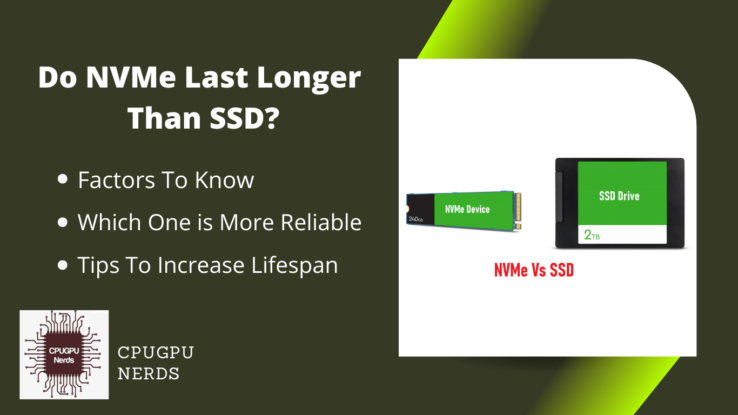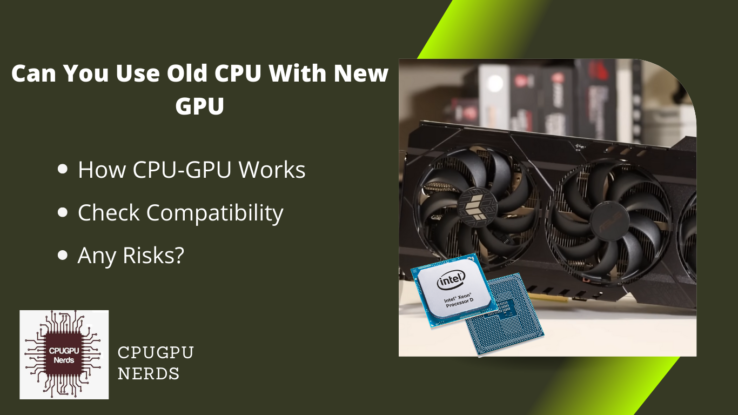NVMe (nonvolatile memory express) is a high-speed storage interface designed for use with solid-state drives (SSDs). It is the successor to the older AHCI interface. NVMe offers several benefits over AHCI, including lower latency, higher bandwidth, and support for more concurrent commands. In addition, it is the latest form of storage device.
If we compare NVMe with the SSD device, the results will be in favor of the NVMe device. These devices are power efficient and have more data writing speed. You can say it is the latest and most efficient data storage device.
Do NVMe Last Longer Than SSD?
It is estimated that the average lifespan of an SSD is 5-6 years, while the average lifespan of an NVMe is more than 10 years. So, no doubt NVMe devices have more lifespan than SSD drives. However, the lifespan of your storage device also depends on the workload and tasks you are performing regularly.
Suppose you are a power user and do multitasking and memory-intensive tasks like video editing, image editing, 3D animations, and pro gaming. In that case, your hard drive’s lifespan will be less than an average user who just manages documents and emails.
The health of your storage device also depends on the external environment. For example, if you have a warm and humid external climate, your NVMe or SSD will also face the overheating issue. Overheating is the worst enemy of your storage device. It decreases the lifespan and may cause issues like data loss and malfunctioning.
The lifespan of both NVMe and SSD depends on whether your device is using SLC, MLC, TLC, or QLC. These are the storage capacity per cell of your memory device. Most of the NVMe is TLC drives and thus have more lifespan than the average QLC SDD drives.
1. SLC Single Level Cell
SLC means that each cell can store one bit of information. This cell type is mostly used in enterprise and high-end devices due to its high reliability and speed. In addition, SLC has the longest lifespan among all types of memory cells.
2. MLC Multi-Level Cell
The MLC type can store two bits per cell. This technology is slower than SLC but is cheaper to manufacture. That’s why MLC is mostly used in SSDs for home users.
3. TLC Triple Level Cell
This type can store three bits per cell and is slower than MLC. In addition, TLC has a shorter lifespan and lowers reliability compared to MLC and SLC. So, it is not recommended to use TLC for important data storage.
4. QLC Quad Level Cell
QLC is the newest technology that can store four bits per cell. However, QLC is slower than TLC and has a shorter lifespan. So, it should be only used for archival purposes.
Is NVMe More Reliable Than SSD?
NVMe is more reliable than SSD as they are the latest devices with a fast response rate. So, no doubt NVMe devices are more durable and reliable than SSDs. They have higher write speeds and longer lifespans. There are more secrets to reveal in the upcoming years as NVMe is the most recent device.
| Memory Type | NVMe | SSD |
| Average Lifespan | 10 Years | 5 Years |
| Bandwith | 3GB/s | 600MB/s |
| Type of cell | TLC | TLC & QLC |
SSD typically uses a SATA interface with a maximum data transfer rate of 600MB/s. So, NVMe is definitely a step up from SSD in terms of storage devices. It is faster, but it’s also more reliable and has a longer lifespan.
The benefits of NVMe don’t stop there. One of the coolest things about NVMe is that it uses PCI Express (PCIe)– which offers lower latency and consumes less power than SATA. So, it is faster and more reliable, but it’s also more energy-efficient.
What Causes NVMe Failure?
You can’t say there is only one factor that leads to NVMe failure. Multiple factors cause the NVMe drives to stop working, leading to permanent failure. Here are some of them:
1. Controller Failure:
One of the most common causes of NVMe failure is controller failure. It can be caused by a variety of things, including manufacturing defects, physical damage, or even just wear and tear over time.
2. Firmware Corruption:
Another common cause of NVMe failure is firmware corruption. It can happen for various reasons, including power surges, software glitches, or even physical damage to the drive.
3. Physical Damage:
Physical damage is fatal damage for any storage device, and NVMe drives are no exception. Things like dropped drives, water damage, or even just regular wear and tear can all lead to physical damage that can render a drive unusable.
4. Data Corruption:
Corrupt data in your storage may also lead to devise failure. It can happen for various reasons, including power surges, software glitches, or even physical damage to the drive. If you have any corrupted data, try to eliminate it from the device for the sake of its health.
5. Overheating:
One of the major issues leading the NVMe to failure is overheating. It can happen for a variety of reasons, including improper cooling, excessive use, or even just physical damage to the drive.
Do NVMe Drives Overheat?
The heat is the major issue in the NVMe devices. They mostly get overheated if you are performing memory-intensive tasks. There are other reasons too, like using the storage over its limit and hot external environment. Overheating destroys your device by damaging the components.
To reduce the thermal throttling, you also have to keep your case environment cool by providing good ventilation. A well-ventilated PC case reduces the overheating issue by up to 70%. So, if you are using sensitive devices like SSD and NVMe, you must pay attention to the proper air ventilation.
The solution to NVMe overheating is to use an NVMe heat spreader. These heat spreaders are designed to spread the heat by increasing the airflow, which speedups up the dissipation process. It results in faster cooling. It is the most efficient way to reduce your NVMe heat and provide instant cooling.
You can also use a PCIe adapter to get some extra air circulation area. But poor quality adapter may affect the performance of your NVMe. For example, using just the heat sink with NVMe reduces the temperature up to 5%, while the heatsink used with the PCIe adapter reduces the temperature up to 15%, which is amazing.
How Often Do NVMe Drives fail?
Compared to SSDs, NVMe drives are said to be more reliable. It is because they have no moving parts, which means that there are fewer things that can go wrong. In addition, they often come with better warranties than SSDs. So, if you’re looking for a drive that will last a long time and be less likely to fail, NVMe is a good option.
In a test, 3 SSD out of 1500 failed in two years of duration while no NVMe was affected. The comparison was between HDD, SSD, and NVMe. It proved that the latest NVMe devices were faster and more reliable than old HDDs and SSDs.
Tips To Increase Lifespan of NVMe and SSDs:
To increase the lifespan of your storage device, you should follow some basic tips like avoiding over storage, physical disturbance, and temperature control. Here is the detail of some important points you have to keep in mind to avoid any damage to your storage devices and increase their lifespan.
1. Store Data Up To a Limit:
Avoid using our drive storage for more than 80%. It will lead to many problems, including performance degradation, memory health issues, data corruption, and data loss. So, always store limited data.
2. Erasing Data Frequently:
void deleting and writing files frequently on your hard drive. When you erase data on an SSD, the drive will be required to erase the entire block of data that was occupied by the file. This will put an extra load on your drive, and it will reduce its lifespan.
3. Keep The Environment Cool:
Avoid using your hard drive in extreme temperature conditions. Storage devices work best in cool temperature conditions. Overheating damages the components and reduces the lifespan of your storage device.
5. Keep The Device Clean:
Keep your hard drive away from dust and other particles. Always use it inside the covered case of your PC. In the case of SSD, dust can damage the internal components, but in the case of NVMe, it can damage it directly as NVMe doesn’t have any cover on them.
6. Avoid Physical Shocks:
Do not drop or physically damage your hard drive. This can cause irreparable damage to your storage device. With proper care and usage, you can increase the lifespan of any storage device, including NVMe and SSD. Furthermore, by following the above-mentioned tips, you can prevent the devices from a fatal issue.
Conclusion
From the above discussion, it is clear that NVMe is more reliable than SSD. It is because NVMe doesn’t have any moving parts, which makes it more durable. In addition, they often come with better warranties than SSDs. So, if you’re looking for a drive that will last a long time and be less likely to fail, NVMe is a good option.

Hey, I’m Hammad. I write for this website to help you with the IT advice about PC, RAM, CPU, Motherboard, PSU, and other PC components.
I will provide detailed guides with images, and explain step by step so you can understand the process. Check all my articles here.





